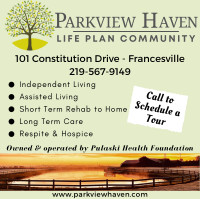The event at the Knights of Columbus hall, Winamac, drew over 75 persons, including county elected officials, business leaders and candidates for county offices. Also present were State Sen. Ed Charbonneau, State Rep. Kendell Culp and representatives from U.S. Sen. Mike Braun and U.S. Rep. Rudy Yakym. A catered dinner was served, followed by the speakers.
Origer, in his annual “State of the County Economy” address, was in a celebratory mood as he announced that thanks to adjustments the county council has made in the last years to the tax schedule, the county now has an $8.7 million* budget surplus.
*In a subsequent review of county finances, taking into account additional factors relating to revenue sources, Origer issued an updated report Sunday (April 28) indicating the county's "actual on-paper surplus is somewhere between $9.4- and $9.5-million, rather than the originally reported $8.7-million.
Origer also reported that progress is being made by the CDC and cooperating organizations for plans to develop more affordable housing in the county, and to secure more and better highspeed internet. In addition, the CDC is in the final stages of a rebuild of the county’s website.
Most importantly to Origer, is the development and adoption of a new county salary matrix which followed lengthy research and input, including an extensive study of the employee salaries of 20 area counties, and thus bringing Pulaski County inline and competitive with its neighbors.
(The full transcript of Origer’s address appears at the end of this article)
‘Main Street IS Economic Development’
Keynote speaker John Bry is the coordinator of the only recognized county-level Main Street organization in the country - in Oakland County, Mich. (north of Detroit). Somewhat unique among Main Street managers, Bry is not only a local-government employee, but specifically works within Oakland County’s multidisciplinary Community Development & Planning Department, bringing a distinct, more comprehensive perspective to downtown development and the ways in which it can have a positive impact beyond the central business district. Oakland County Main Street and the Oakland County Community Development and Planning Department serves a county that ranges from Detroit suburbs to heavily rural areas dotted by villages similar in size to Pulaski County’s towns and small cities in neighboring counties.
The first thing he emphasized is that “Main Street IS economic development, not just decorating downtown to make it look pretty.”
Originally a Hoosier hailing from northeastern Indiana, Bry was named the 2023 Mary Means Leadership Award recipient by Main Street America in recognition of his outstanding leadership in the field of comprehensive preservation-based economic development and commercial district revitalization. He began with the Main Street program as an intern in Indiana Gov. Evan Bayh’s administration, and is nationally certified with the program.
Since he’s a native-born Hoosier, Bry joked that he has developed a David Letterman-style “Top 10 List” for Main Street strategies:
No. 10 – “Soul of the Community.” Bry recommends identifying and preserving the area(s) of a town that residents associate with it. He said for him it is his hometown’s courthouse square. Other examples are parks, landmarks or historic locations – anything that captures the attention of visitors or motorists passing through. (Hint: It’s never a Walmart)
No. 9 – Entrepreneurship. This is the core, the significant part of the downtown economy. Feed and protect it.
No. 8 – Heritage and Culture. Blend economic development with the historic heritage of downtown.
No. 7 – “Downtown is the Calling Card of the Community.” Bry insists that if the downtown doesn’t look good, people will think “something is wrong here.”
No. 6 – Give Back to the Community. Bry asked the business owners in the audience about how often they are solicited to donate to community projects. (Knowing laughter circulated the room.) He instructed Main Street leaders to keep these statistics, because the people of the community don’t realize how much is given by business owners who “don’t get recognized.”
No. 5 – Talent. Bry warned downtowns will always battle for talent – attracting it, developing it, keeping it.
No. 4 – Ripple Effect. Bry encouraged Main Street programs to look for ways to tie assets together with the downtown, such as neighborhoods, parks, trails and historic sites. He suggested “walkable” events which are popular, such as festivals. “Develop a ‘Trail Town’ economy,” he recommended.
No. 3 – Employment Center. Make note of how many people are employed downtown, Bry said. “Keep those stats” for economic purposes.
No. 2 – Leveraging the Power of Place. This is for investment, infrastructure and identification purposes.
No. 1 – Cha-Ching. Show Me the Money (revenue). Developing downtown is about building an economy. “Tell your story through your stats,” Bry said. “What are you making?”
After listing his Top 10, Bry was still chock-full of advice: “Be bold, be creative, be you.” He told the story of one of his communities closing a downtown parking lot to build a quaint community gathering space used as a concert venue, the town’s farmers’ market and for other purposes. Doubters thought it was a crazy idea. Turns out the facility is hugely popular and brings in revenue. The parking lot didn’t.
He also advised towns to use their assets. “Historic buildings are assets,” he said. ‘No one wants to look at plain.”
Bry emphasized that leaders should gather and use data, and have a strategy (or two). “What can your downtown be now?”
A major point he raised was change. “Avoid steps to stagnation,” Bry said. “How many meetings have you attended where someone says, ‘We’ve never done that.’ ‘That will never work!’”
Just as important, he noted that most projects are “not fast, cheap or easy.” Projects can take years to complete. But sometimes they can be done in stages.
Finally, he encouraged “repeat, repeat, repeat.” A new project plan must be messaged again and again until every participant understands it. “Partnerships and collaborations make the world go round,” Bry said. “Talk to each other ALOT and OFTEN. Leadership is everything.”
2024 State of the Pulaski County Economy
By Nathan P. Origer, Executive Director
Pulaski County Community Development Commission
I must confess that, every year, without fail, I feel a bit fraudulent when I give this talk: I promote it as the State of the County Economy address, but it always encompasses more than just that. While a more disciplined person might rein it in, I let this happen for two reasons: my real job description has expanded so far beyond the written document, and I believe — if you’ll forgive the jargon — not only that economic development doesn’t exist as a silo and is interwoven with quality-of-life and quality-of-place initiatives, but also that this more broadly conceived community development isn’t an island and is connected to everything from the local government’s fiscal health to historic preservation to the attitude that our community and its institutions display toward issues like mental health and substance abuse.
If we go back in time nearly a decade now, we see that it was county finances that first catalyzed the ever-expanding nature of my job: it was unclear to me how I was supposed to facilitate healthy economic growth when our finances were in disarray, our income-tax rate the highest in Indiana.
Most rural counties across the country have been losing population; we lost an alarming 89 residents per year between the 2010 and 2020 Censuses — a decline of 6.626%. Compare this to the previous decade, when we lost fewer than 40 per year. A number of factors surely contributed to rapid demographic decline, but it’s hard to ignore the 3.38% elephant in the room. And despite that state-highest income tax, we were heading the wrong way financially. I won’t dive deep into what led to this situation, but, in short, the county had made too many decisions that were probably, in and of themselves, reasonable policies, but combined to hurt both resident wage earners and the county’s treasury.
And yet, now, I am filled with elation.
In 2019, the County Council made the difficult decision to thaw the freeze on our maximum levy, allowing general operating property taxes to increase for the first time in more than a decade. In 2020, after failing to secure enough votes in the previous year, Ken Boswell and I worked with Baker Tilly and presented a plan to overhaul our income taxes that simultaneously reduced the rate and increased revenue. We had the votes this time — all seven of them.
This year, Pulaski County has an on-paper surplus of about $8.7 million.* With the inclusion of other funds that I left out, that actually grows to more than $12 million, but I wanted to be conservative and to avoid including funds so tightly restricted as to be virtually irrelevant.
From 2020 through this year, the levy thaw has generated just shy of $2.72 million in property tax receipts above where the county would be if the freeze were still in place. Including this year’s revenues, the magical rate reduction that completely upended our income-tax allocations has brought in more than $5.9 million above baseline. Combined, these tough but necessary decisions have led to $8,655,807 in new revenue.
Avoiding demise; here to celebrate
Without these efforts, that seven-digit surplus would be less than $65,000 this year. By this time next year, we might have found ourselves wondering which neighboring counties would be annexing which of our townships. Instead, we are here to celebrate — and it’s not only our financial health that has improved.
*In a subsequent review of county finances, taking into additional factors relating to revenue sources, Origer issued an updated report Sunday (April 28) indicating the county's "actual on-paper surplus is somewhere between $9.4- and $9.5-million, rather than the originally reported $8.7-million. Origer also updated Sunday that "our on-paper surplus without the County Council's actions in 2019 and 2020 would be somewhere between $800,000 and $900,000, rather than less than $65,000 — substantially better than I reported, but still nowhere near what it is now."
We’re only a few years into the decade, and these numbers are estimates that ultimately may be subject to revision, but, according to the Census Bureau, Pulaski County lost 130 people from 2020 through 2023. As much as we’d love to see population growth, I think it’s worth appreciating that, thus far, we’re losing about 43 people per year — roughly half the decline we suffered over the previous decade —, and that this slowdown began when residents started keeping more of their paychecks in their bank accounts. Imagine what things might look like if we were to cut the income-tax rate even further.
What’s perhaps most reassuring is that, after a slight decline, the number of residents in each age cohort from birth to 44 years looks to be turning back in the right direction, however slowly, along with an ever-growing population of senior citizens. It’s basically only Generation X (people born between 1965 and 1980) letting us down, while everyone else is standing firm (but I, for one, still appreciate that cohort’s cynicism).
We are potentially less than a year away from solar-project construction in Pulaski County.[I know that many of you just cringed as I said the ‘s’-word, and it’s not my intention to pour salt in any wounds. There are certainly concerns with large-scale projects, and we need to be open to improving our ordinance, but there aren’t many opportunities in life for a county to undo all of the fiscal damage it did to itself over the course of nearly 20 years.
This is probably our only chance.
I contemplated just a moment ago what might happen to our population if we could further reduce our income-tax rate. Currently, 0.35% of the rate surpasses the Expenditure Rate cap of 2.50%, generating $1.14 million in property-tax replacement-credit revenue — income that, rather than funding our operations directly, provides dollar-for-dollar reductions to property-tax bills. The nearly $2 million in taxes that these projects would generate cumulatively even in their earliest years of operations would be enough to eliminate this component of the income tax, bringing the rate down to 2.50%, while also paying the entire annual debt service for the justice-center project and still contributing another $500,000 or so to the county’s treasury to the benefit of every other taxpayer.
Over a period of about two decades, these projects are expected to generate $75 million or more in property taxes above what the acreage currently is generating as agricultural land — $75 million that every other taxpayer won’t have to cover.
On top of that, we expect to receive between $40- and $63-million in economic development payments — discretionary income with virtually no strings attached — over 15 to 20 years. The taxpayers’ share of the debt service on our courthouse renovation could be cut by 25- to 50-percent, and there’d still be money left to support a work-release facility, more robust judicial-system programs meant to help residents to overcome addiction, workforce-training opportunities, amenities to make our fair community even more attractive to tourists and residents — any or all of these. The transformative value of these projects cannot be overstated, and the debate over property rights, financial benefits, and protecting neighbors does not have to be a zero-sum game unless we allow it to be one.
But it’s not all about solar. Really, it’s not. The flexibility we’d have to accomplish more sooner with that money is virtually unfathomable; but, while timing may be dependent on the availability of funds, our vision for community development doesn’t hinge on these projects.
Simply Pulaski
Late in 2021, we adopted Simply Pulaski, an update to our 2010 strategic plan. Since then, between courthouse project meetings, analyzing wages paid by nearly 20 other Indiana counties, and live-streaming county meetings, we’ve been working on implementing this plan bit by bit.
Last year, the Board of Commissioners and Council comprehensively restructured how community development is managed in Pulaski County, reorganizing the Community Development Commission and establishing a number of specialized bodies — economic and redevelopment commissions, a rebooted advisory commission on industrial development, and a tourism advisory council — all meant to align members’ interests and skillsets with specific responsibilities.
The Economic Development Commission has already offered its first recommendation to the Council regarding a tax-abatement request and, pursuant to its Council-adopted enabling ordinance, begun work on an application, scoring rubric, and set of guidelines for this incentive so that the Council can ensure that it’s making the fairest, most objective decisions possible when balancing efforts to support new investment with protecting taxpayers.
Once the program has been re-opened, the E.D.C. will take responsibility for reviewing applications to our fantastic revolving-loan fund.
The Tourism Advisory Council is working on fleshing out a full-fledged tourism strategic plan and hopes to produce an updated commercial for television marketing along with shorter videos for social-media use, among other goals.
Our Redevelopment Commission is ready to take the reins when we move forward with our proposed Pleasant View Village, a new residential neighborhood planned for county-farm property intended to expand housing options at price points suitable for our manufacturing workforce. This project, the result of the efforts of our housing taskforce in partnership with the Community Foundation of Pulaski County and the Housing Resource Hub, is one of several prongs of our approach to addressing housing needs in the community, and we have our fingers crossed that the gods of the state’s READI 2.0 program will see fit to allocate funding to support this initiative.
The Indiana Housing and Community Development Authority has just announced that Sullivan Development will receive low-income–housing tax-credit support for its proposed Willow Creek Villas project on Galbreath Drive in Winamac. With state support for this project, we’re going to see an incredible transformation of this property within walking distance of Sanders, Ace, CVS, a dollar store and more.
In partnership with Club 720 — a sibling-entity to the Housing Resource Hub — and the Fort Wayne Housing Authority, we’re working to bring the Hoosier Homes down-payment–assistance program to qualifying Pulaski County homebuyers to turn the dream of homeownership into a more affordable reality.
We all know that Pulaski County has an incredible history of entrepreneurship, from Ralph Braun and Don Galbreath to Walter Pesaresi and E.C. Overmyer to successful R.L.F borrowers like CDC president Sheila Hazemi-Jimenez of Tippy’s and Sandy Saltsman of Meadow Springs. There will never be enough that we can do to support these homegrown risk-takers.
I spent most of the day of this year’s Summit in LaPorte with colleagues from across northwestern Indiana and our consultants as we work toward finishing up our READI-funded regional rural entrepreneurship and innovation toolkit. We had great discussion around a really interesting presentation, and honestly, I felt the most inspired I have on this front in a long while just because of the environment in which I found myself. I am thrilled by what this toolkit is going to look like.
If we can find enough budding entrepreneurs willing and able to spend a couple hours a week for five or six weeks receiving free training, we’ll be welcoming our friends from Lafayette’s MatchBOX co-working studio back to town to provide WHIN-underwritten training through their Regional Accelerator Program. And, of course, we do our best to maintain strong relationships with the great people at the Northwest Indiana Small Business Development Center and the Regional Development Company, where I serve on the loan committee.
Just as entrepreneurship seems to bubble up from the Tippecanoe and the Monon, agriculture is at the core of our identity. Through my counterpart in Jasper County, we have just executed an agreement with two expert consultants to guide our READI-funded efforts to turn our regional ag-value strategy into opportunities for growth and diversification. There are a number of directions in which this project may ultimately lead; I hope that one of them is the development of sustainable, robust infrastructure that makes it easier and more cost-effective to find more locally and regionally grown foods in Sanders, the Francesville Market, and other locally owned grocery stores and restaurants across northwestern Indiana.
I don’t need to remind anyone of how critical reliable, affordable, and fast internet service is. We’ve offered letters of support for six providers seeking state funding to assist their efforts to bring connectivity to every acre of Pulaski County. Once the state has announced the winners of this year’s round of Next Level Connections grants, we’ll assess the situation with our Broadband Taskforce and, if needed, distribute a request for proposals to help us to develop a broadband plan to ensure that we have a pathway laid out for filling every connectivity gap from Lawton to Lakeside to Radioville.
We continue to partner with the Center of Workforce Innovations and WorkOne to explore new and better opportunities for bringing skills training to both our existing workforce and high-school students who soon will be stepping into careers.
And we saw another reassuring sign of BraunAbility’s commitment to this community with the massive renovations of their Winamac offices last year.
The sun is shining brightly on Pulaski County.
‘Amazing steps forward’
Of course, in addition to all of these strategic-plan initiatives and more, we’ve allocated a fair amount of time to supporting other county projects.
In case you missed it, over the last couple of weeks, the Council and Board of Commissioners took the last required steps toward moving forward with a comprehensive rehabilitation of our historic courthouse. I’ve started hallucinating in Luminaut orange and Tonn-and-Blank blue and yellow, and my pickup truck reminds me of what a fuel-inefficient death trap it is every time I move furniture from downtown to the highway garage, but what an incredible tag-team victory this is for the past and the future over a present too often inclined toward pennywise dollar-foolishness! This is only the second or third step in what I hope is a continuing effort toward facilities improvements and footprint reduction, but it’s a tremendous one.
Our developers are about halfway through a rebuild of the county’s website — a project that will culminate in a fresher, stabilized, and user-friendlier portal where the public can access contact information; meeting agendas, minutes, and live-streams; all the news that’s fit to print about paintball, kayaks, bike trails, baboons and more; and why we say ‘Pulask-eye’ instead of ‘Pulask-ee.’
I have been uniquely blessed to have played central roles in some amazing steps forward in Pulaski County — the overhaul of our income-tax rate and allocations, the justice-center and courthouse projects, the forgivable loan that helped Winamac Coil Spring to return to Pulaski County, the loan that saved the last lumberyard in the community and more.
Perhaps none has been as great of an honor as helping to ensure that my colleagues in county government are paid a respectable wage. Late last year, working with the data that we collected and presented, the Council adopted a sweeping overhaul of Pulaski County’s wage-and-salary matrix and pay for virtually everyone serving the public in this wonderful community — and we did it while still ending up with that aforementioned $8.7-million surplus.
To have been part of this project is enough of a privilege; knowing that we improved the quality of life of everyone who comes to work in the morning to serve the people of Pulaski County without stressing our not-so-long-ago-fragile finances is remarkable enough to leave me speechless — so this seems like a fitting time to draw this talk to a conclusion.
Community development is a team sport, and all of Pulaski County is in the lineup. Our strategic plan is our playbook for a vibrant, sustainable, healthier and wealthier Pulaski County; we can only go so far in implementing it without the active engagement of our wonderful partners, like the Community Foundation, major employers, and our county and town governments. We can only go so far in implementing it without the active engagement and support of the members of this fantastic community.







